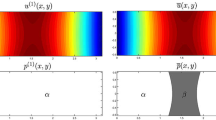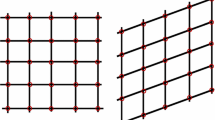Abstract
An angle plate is a multistructure consisting of two plate-like substructures meeting at a right angle. We regard it as obtained from a single plate by a thought process of folding such as to affect the material behavior only in the “elbow” region. We model the three-dimensional plate-like material region corresponding to the plate to fold as being transversely isotropic with respect to an axis orthogonal to its base surface, with admissible displacements in the Reissner-Mindlin's form. After folding, we require that in the “elbow” region the material be doubly transversely isotropic and the displacement be the common restriction of the admissible displacements in the two “arm” plates. Under these assumptions, from a three-dimensional virtual-work formulation of equilibrium we deduce by mere thickness integration the field, boundary, and transmission equations of our two-dimensional model of a linearly elastic angle plate. Various generalizations of this model are possible, some of which we occasionally indicate.
Similar content being viewed by others
REFERENCES
M. Bernadou and A. Cubier, Numerical analysis of junctions between thin shells. I. Continuous problems. Comput. Methods Appl. Mech. Engrg. 161(1998) 349–363.
M. Bernadou and A. Cubier, Numerical analysis of junctions between thin shells. II. Approximation by finite element methods. Comput. Methods Appl. Mech. Engrg. 161(1998) 365–387.
M. Bernadou, S. Fayolle and F. Léné, Numerical analysis of junctions between plates. Comput. Methods Appl. Mech. Engrg. 74(1989) 307–326.
P.G. Ciarlet, Mathematical Elasticity, Vol. II: Theory of Plates. Elsevier, Amsterdam (1997).
P.G. Ciarlet and P. Destuynder, A justification of a nonlinear model in plate theory. Comput. Methods Appl. Mech. Engrg. 17/18(1979) 227–258.
A. DiCarlo, P. Podio-Guidugli, and W.O. Williams, Shells with thickness distension. Internat. J. Solids Struct. 38(2001) 1201–1225.
H. Le Dret, Folded plates revisited. Comput. Mech. 5(1989) 345–365.
H. Le Dret, Modeling of a folded plate. Comput. Mech. 5(1990) 402–416.
H. Le Dret, Problémes variationnels dans les multi-domains. Research Notes in Applied Mathematics, Masson, Paris (1991).
P. Nardinocchi, Modelling junctions of thin bodies. In preparation (2000).
P. Podio-Guidugli, An exact derivation of the thin plate equation. J. Elasticity 22(1989) 121–133.
E. Sanchez-Palencia, Sur certain problémes de couplage de plaques et de barres. In: Équations aux Dérivées Partielles et Applications. Articles dédiés à J.L. Lions. Elsevier, Amsterdam (1998) pp. 725–744.
I. Titeux and E. Sanchez-Palencia, Junction of thin plates. C. R. Acad. Sci. Paris Sér. Iib 325(1997) 563–570.
I. Titeux and E. Sanchez-Palencia, Junction of thin plates. European J. Mech. A Solids 19(2000) 377–400.
Author information
Authors and Affiliations
Rights and permissions
About this article
Cite this article
Nardinocchi, P., Podio-Guidugli, P. Angle Plates. Journal of Elasticity 63, 19–53 (2001). https://doi.org/10.1023/A:1013001821396
Issue Date:
DOI: https://doi.org/10.1023/A:1013001821396




